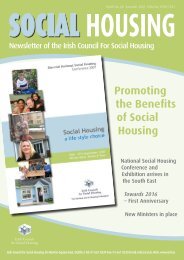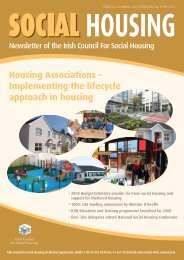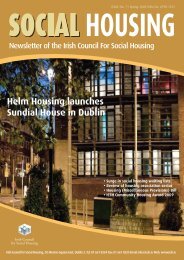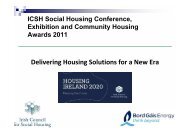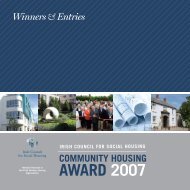National Housing Strategy for People with a Disability 2011 - 2016
National Housing Strategy for People with a Disability 2011 - 2016
National Housing Strategy for People with a Disability 2011 - 2016
Create successful ePaper yourself
Turn your PDF publications into a flip-book with our unique Google optimized e-Paper software.
Chapter 9Mental Health <strong>Disability</strong>9.1 The provision of good quality, secure and appropriate housing is recognised as a keyfactor, in conjunction <strong>with</strong> education and employment/occupation, in facilitating recoveryfrom, or managing, a mental health disability. The Australian Human Rights and EqualOpportunities Commission found that: “One of the biggest obstacles in the lives of people<strong>with</strong> mental illness is the absence of adequate af<strong>for</strong>dable and secure accommodation.Living <strong>with</strong> a mental illness, or recovering from it, is difficult even in the best circumstances.Without a decent place to live it is virtually impossible” 66 .9.2 It is essential, there<strong>for</strong>e, that in developing a national housing strategy <strong>for</strong> people<strong>with</strong> disabilities, the specific and complex housing needs of people <strong>with</strong> a mental healthdisability be identified and addressed effectively in order to assist in the promotion andsustainment of recovery. A mental health disability is often an unseen disability <strong>with</strong> theresult that it may not be acknowledged how seriously disabling it can be, which can lead toa lack of recognition and understanding by society.9.3 For the purposes of this strategy, it is recognised that specific housing needs mayarise as a result of a mental health disability, <strong>for</strong> which intervention and treatment may beongoing, but they may also arise from a single or isolated episodic event, which, althoughnot requiring constant intervention, has a severe impact on a person’s ability to access andmaintain housing that is appropriate and conducive to recovery.9.4 A Mental Health Subgroup 67 was established to examine the specific housing issuesarising as a result of a mental health disability 68 . To in<strong>for</strong>m the work of the subgroup,research was undertaken by the <strong>Housing</strong> and Sustainable Communities Agency in relation tothe housing and support needs of people <strong>with</strong> a mental health disability in Ireland.Data9.5 It is recognised that there are limitations in existing data in relation to the livingarrangements of people <strong>with</strong> a mental health disability. Census figures from 2006 indicatethat 16% of those who reported a disability reported a “psychological or emotionalcondition” 69 – that is approximately 65,000 people.9.6 Chart 9.a below illustrates the illnesses causing emotional, psychological & mentalhealth disability reported by respondents to the <strong>National</strong> <strong>Disability</strong> Survey (NDS) (the66Human Rights and Mental Illness, Report of the <strong>National</strong> Inquiry into the Human Rights of people <strong>with</strong> MentalIllness. Human rights and Equal Opportunity Commission, Australian Government Publishing Service Canberra1993.67The membership of the Mental Health Subgroup is set out at Appendix 2.68The aims and objectives of the mental Health Subgroup are set out at Appendix 3.69For the purpose of this strategy, it is understood that the “psychological or emotional condition” category, asrecorded in Census 2006, includes people <strong>with</strong> a mental health disability. All census figures are self reported.99



